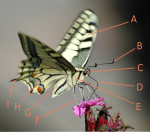Portal:Arthropods/Selected article/25
The external morphology of Lepidoptera is the physiological structure of the bodies of insects belonging to the order Lepidoptera, also known as butterflies and moths. Lepidoptera are distinguished from other orders principally by the presence of scales on the external parts of the body and appendages, especially the wings. Butterflies and moths vary in size from microlepidoptera only a few millimetres long, to conspicuous animals with a wingspan of many inches, such as the Monarch butterfly and Atlas moth.
The larvae – caterpillars – have a toughened (sclerotised) head capsule, chewing mouthparts, and a soft body, that may have hair-like or other projections, 3 pairs of true legs, and up to 5 pairs of prolegs.
Adults have a hardened exoskeleton, except for the abdomen which is less sclerotised. Their mouthparts include a prominent proboscis formed from maxillary galeae, and are adapted for sucking nectar. They have two immobile, multi-faceted compound eyes, and only two simple eyes or ocelli. Antennae are prominent and besides the faculty of smell, act as olfactory radar, and also aid navigation, orientation and balance during flight. (Full article...)

